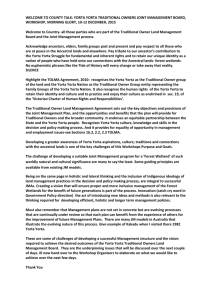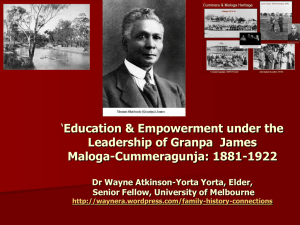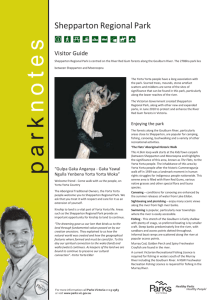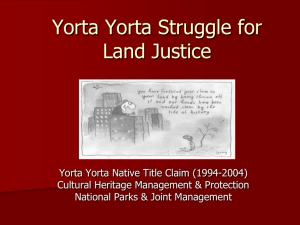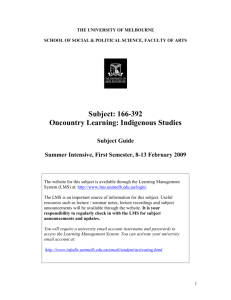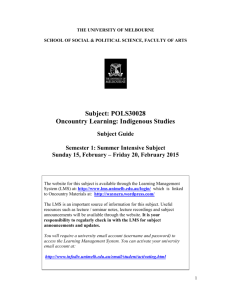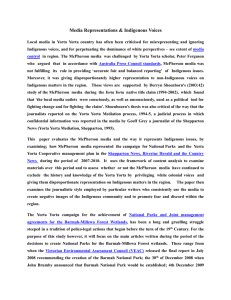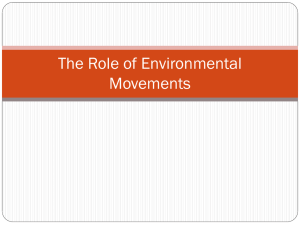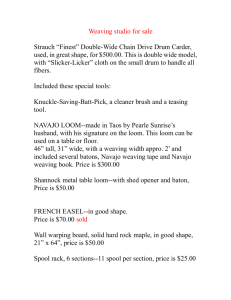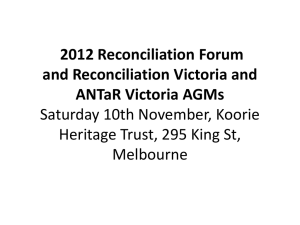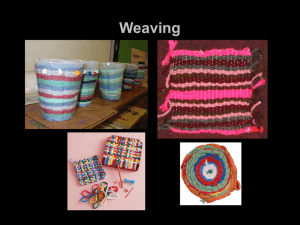A full copy of this research including footnotes is
advertisement
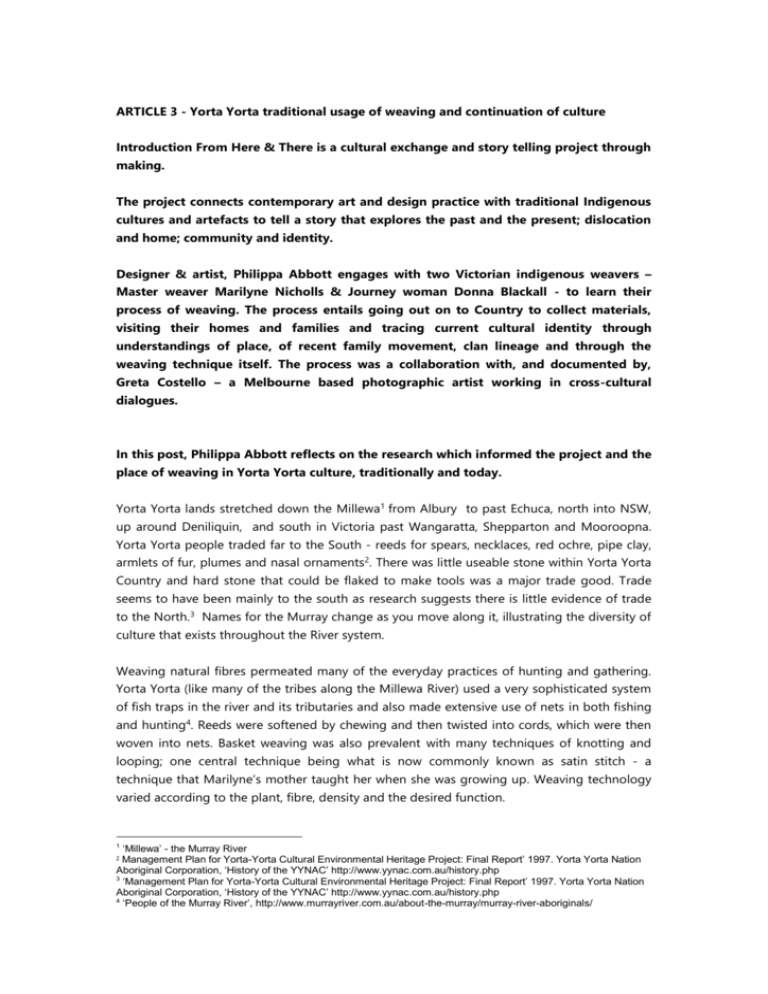
ARTICLE 3 - Yorta Yorta traditional usage of weaving and continuation of culture Introduction From Here & There is a cultural exchange and story telling project through making. The project connects contemporary art and design practice with traditional Indigenous cultures and artefacts to tell a story that explores the past and the present; dislocation and home; community and identity. Designer & artist, Philippa Abbott engages with two Victorian indigenous weavers – Master weaver Marilyne Nicholls & Journey woman Donna Blackall - to learn their process of weaving. The process entails going out on to Country to collect materials, visiting their homes and families and tracing current cultural identity through understandings of place, of recent family movement, clan lineage and through the weaving technique itself. The process was a collaboration with, and documented by, Greta Costello – a Melbourne based photographic artist working in cross-cultural dialogues. In this post, Philippa Abbott reflects on the research which informed the project and the place of weaving in Yorta Yorta culture, traditionally and today. Yorta Yorta lands stretched down the Millewa1 from Albury to past Echuca, north into NSW, up around Deniliquin, and south in Victoria past Wangaratta, Shepparton and Mooroopna. Yorta Yorta people traded far to the South - reeds for spears, necklaces, red ochre, pipe clay, armlets of fur, plumes and nasal ornaments2. There was little useable stone within Yorta Yorta Country and hard stone that could be flaked to make tools was a major trade good. Trade seems to have been mainly to the south as research suggests there is little evidence of trade to the North.3 Names for the Murray change as you move along it, illustrating the diversity of culture that exists throughout the River system. Weaving natural fibres permeated many of the everyday practices of hunting and gathering. Yorta Yorta (like many of the tribes along the Millewa River) used a very sophisticated system of fish traps in the river and its tributaries and also made extensive use of nets in both fishing and hunting4. Reeds were softened by chewing and then twisted into cords, which were then woven into nets. Basket weaving was also prevalent with many techniques of knotting and looping; one central technique being what is now commonly known as satin stitch - a technique that Marilyne’s mother taught her when she was growing up. Weaving technology varied according to the plant, fibre, density and the desired function. ‘Millewa’ - the Murray River Management Plan for Yorta-Yorta Cultural Environmental Heritage Project: Final Report’ 1997. Yorta Yorta Nation Aboriginal Corporation, ‘History of the YYNAC’ http://www.yynac.com.au/history.php 3 ‘Management Plan for Yorta-Yorta Cultural Environmental Heritage Project: Final Report’ 1997. Yorta Yorta Nation Aboriginal Corporation, ‘History of the YYNAC’ http://www.yynac.com.au/history.php 4 ‘People of the Murray River’, http://www.murrayriver.com.au/about-the-murray/murray-river-aboriginals/ 1 2 Weaving was also used for the creation of barricades during times of flood overflow to billabongs that would then catch large amounts of fish. An early non-Indigenous squatter in the 1840s reports seeing nets up to 90 metres long used for hunting emu and kangaroo - a significant collective effort involving large numbers of people to make and utilise 5. This practice was wiped out with colonisation. A sad fact is many of the remaining pre-1850s original Victorian artefacts are held in the British Museum and can no longer be found in Australia – a testament to the huge and swift loss of cultural technique and artefacts, and the nostalgic representation of them. The Yorta Yorta were impacted by white colonisation from the 1820s onwards and are estimated to have declined by approximately 85% within one generation from an original population of 5000-6000 pre-colonisation6. The survivors were dispersed and lived on the fringes of white settlement until the first mission was established in the 1870s; one of these is Maloga Mission (1874) on the New South Wales side of the Millewa River. This eventually closed down and the residents were sent to Cummeragunja Mission(1888-9). Cummeragunja was an important relocation for Yorta Yorta people to regroup. Here a consolidation of surviving culture and mob within the mission occurred and was a precursor to the political movement in the 1930s led by some of Australia’s outstanding political leaders such as Uncle William Cooper7. Dispossession and destruction in Victoria was rapid - squatters came south from Sydney but more significantly established graziers (and speculators) came over from van Diemens Land and seized land before there was an effective government presence. There was an accelerated and violent land grab as these ‘settlers’ tried to get as much land as possible before any control was established. Many of the First People drifted or fled south away from settlement along the Murray along pre-existing trading links or sometimes through kinship ties. People were put into missions in a very arbitrary way regardless of whether they had any real links to an area through existing lineage or cultural association. Marilyne told us the story of how her mother in her time (in the 1930-40s) when she and her brothers and sisters went out with a relative to the town butcher. As they waited out the front of the butcher shop, a White man offered them lollies – the Aunty they were with came out of the shop before they had had a chance to eat them. She threw them down on the ground where the dogs ate them up – the dogs then died as they had been poisoned. This was in this century. The ongoing harassment and violence that occurred well beyond the original period of ‘settlement’, missions and uprisings is difficult to comprehend and serves to show that Australians cannot look at this as past wrongs safely consigned to history books. Management Plan for Yorta-Yorta Cultural Environmental Heritage Project: Final Report’ 1997. Yorta Yorta Nation Aboriginal Corporation, ‘History of the YYNAC’ http://www.yynac.com.au/history.php 6 Dr Watkinson - Yorta Yorta Elder, History of the YYNAC’ Yorta Yorta Nation Aborignal Cooperation, http://www.yynac.com.au/history.php 7 Dr Watkinson - Yorta Yorta Elder, History of the YYNAC’ Yorta Yorta Nation Aborignal Cooperation, http://www.yynac.com.au/history.php 5 “Our ability to endure these forces and to survive as a people is an amazing example of the strength and courage of our ancestors, and a sad reflection on the mindset and brutality of the perpetrators of the scale of destruction that took place within such a short period of time.”8 [Dr Wayne Atkinson-Yorta Yorta Elder] Weaving was a cultural practice and storytelling process that helped to keep culture alive. According to family members of both Donna and Marilyne, women were still weaving using traditional techniques within the missions for everyday use and this has been passed down generations. During the 1960s when Marilyne’s family was living outside of Swan Hill, Aboriginal people were still not allowed to live in the township. They lived in a corrugated tin shack on the outskirts of town. They would share what they had between the few other Indigenous families living there. Marilyne’s mother would supplement her income through weaving and selling the baskets providing a much-needed resource to support her family. Many of the weaving techniques were lost and so now it becomes a process of relearning and putting the jigsaw pieces back together despite the gaps. Marilyne’s journey to rediscover Yorta Yorta techniques of Dilly bag making took her and four other Victorian Master Weavers to the Arnhem weavers in Northern Territory. She is now one of the few, perhaps the only, Victorian Master Weaver who has relearned this intricate and painstaking technique which involves creating fine yarn from grass before the weaving process can begin. Yorta Yorta have overtime began slowly to reweave their cultural history into a current story. With such a large cultural gap caused by the dispossession and dispersal this illustrates the strength of these people in the face of such adversity. A very difficult example of this ‘gap’ is the Yorta Yorta native title claim (1994), which was unsuccessful. The courts wanted claimants to demonstrate continuous heritage as it was at the time of settlement 9 . The Yorta Yorta had experienced accelerated and widespread destruction and were unable to provide the necessary (continuous heritage) information as required by the modern court. This highlighted gaps in the legal system, discrepancies within the Native Title Act, and cultural ignorance of modern ‘white’ legal systems. “This was in many cases difficult to prove. On the one hand Indigenous history and culture relies on an oral rather than a written tradition. On the other, the traditional lives of Victorian Aborigines had changed beyond recognition since the arrival of European settlers. This resulted in the loss of language, cultural practices and land.”10 They argued culture is dynamic and continuity is demonstrated by the blending of traditional practices and evolving responses to changing circumstances over time. "...[the] continuity of Yorta Yorta association with and to country [is] through evolution, adaptation and change."11 Dr Watkinson - Yorta Yorta Elder, History of the YYNAC’ Yorta Yorta Nation Aborignal Cooperation, http://www.yynac.com.au/history.php 9 The Yorta Yorta Native Title Determination Application, Peter Seidel & Arnold Bloch Leibler, in Working with the Native Title Act: Alternatives to the Adversarial Method, ed Lisa Strelein, Institute of Aboriginal And Torres Strait Islander Studies (IATSIS) 1998. 10 “Native Title and Yorta Yorta” http://ergo.slv.vic.gov.au/explore-history/fight-rights/indigenous-rights/native-titleyorta-yorta 11 The Yorta Yorta Native Title Determination Application, Peter Seidel & Arnold Bloch Leibler, in Working with the Native Title Act: Alternatives to the Adversarial Method, ed Lisa Strelein, Institute of Aboriginal And Torres Strait Islander Studies (IATSIS) 1998. 8 Although the Native Title claim was not upheld in 2004, a cooperative agreement was signed by the Victorian government with the Yorta Yorta that included recognition of public land, rivers and lakes throughout north-central Victoria. Again demonstrating an ongoing battle... Culture evolves and changes and expresses itself both in new ways and by adaptation of traditional activities to new techniques, materials and purposes. Weaving is an example of how the lines have been broken but the remnants of ancestral practice can be joined with new ways. For more information on Victorian Aboriginal population the Victorian Government has produced the guide "Aboriginal Victoria: a Guide to Discovering Aboriginal Victoria (2007)” which describes a number of indigenous art and cultural centres in Victoria.
